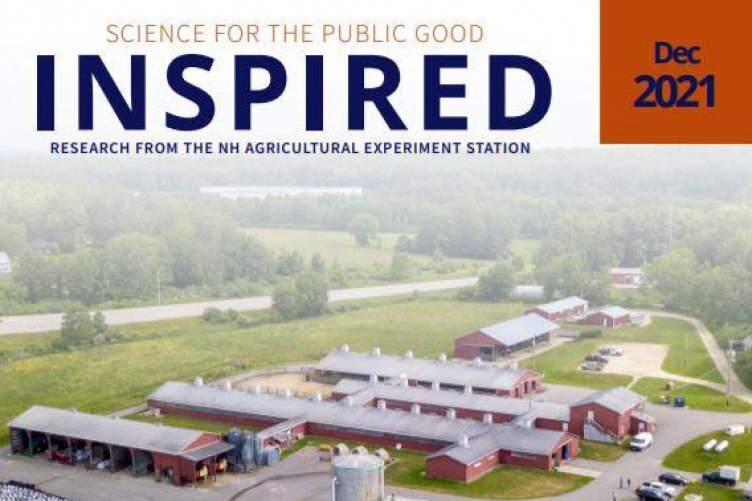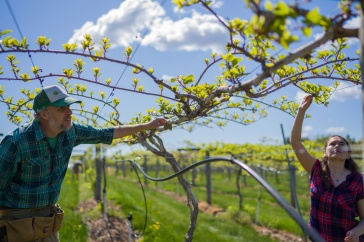
The 2021 UNH Dairy Research Report, which presents the latest dairy research conducted at the University of New Hampshire is available electronically from tthe NH Agricultural Experiment Station.
"It's exciting to be able to share such a variety of science-based insights and recommendations with our dairy stakeholders in New Hampshire and beyond. Many of the questions and challenges addressed by the research were locally inspired through conversations with dairy producers and processors, but the answers to these questions often go beyond the most direct solutions. Rather, they integrate components that ensure economic and environmental sustainability, exemplifying the NH Agricultural Experiment Station's mission of developing science for the public good," said Anton Bekkerman, director of the NH Agricultural Experiment Station.
Research presented in the report includes:
• Whether dairy producers can increase the number of heifers born without using sexed semen.
• Whether perennial ryegrass as a forage species is a good choice for New Hampshire producers.
• The effects of selisseo on selenium in milk and blood for mid- and late-lactation Holstein cows.
• The effects of supplemental mycotoxin deactivator on lactation performance and rumen parameters.
• Plasma dose response techniques for bioavailability of rumen-protected amino acids.
• The impact of direct-fed enzymes and microbials on the health and performance of dairy cows.
• The effects of nicotinic acid on prepartum cow health, colostrum, and calf performance.
• The effects of the NSAID meloxicam on immunoglobulin uptake and preweaning calf performance in newborn calves.
• The effects on growth performance and health of feeding sodium butyrate to post-weaned replacement heifers.
• The preservation and feeding of wet brewer’s grains to post-weaned heifers.
• The effects of incremental amounts of the red seaweed Chondrus crispus on milk production and composition and enteric methane emissions in dairy cows.
• The effects of feeding grazed forage canola on milk production and enteric methane emissions in organic Jersey dairy cows.
• The effects of feeding alfalfa-grass or red clover-grass on milk production and composition, and nitrogen and energy utilization in organic Jersey dairy cows.
• The effects of partially replacing red clover-grass mixture with an alfalfa/white clover-grass mixture on milk production and composition, nutrient digestibility, and nitrogen and energy utilization in organic Jersey dairy cows.
The New Hampshire dairy industry is located primarily in the Connecticut River Valley on the state’s western borders and along the Merrimack River Valley in the center of the state. According to Granite State Dairy Promotion, there are approximately 94 dairy farms in New Hampshire with an average of 120 milking animals per farm.
Dairy research at UNH is conducted at two dairy research farms, the Fairchild Dairy Teaching and Research Center, and the Organic Dairy Research Farm. Research at the Fairchild Dairy Farm focuses primarily on dairy nutrition and reproductive biology. A conventional dairy farm, it is home to about 90 milking-age cows and approximately 70 growing, replacement animals. Milk production averages about 26,000 to 27,000 pounds per cow per year.
The first of its kind in the nation, the Organic Dairy Farm is managed as an integrated agro-ecosystem that includes the biological, physical, and human-related components. Research priorities are relevant to both organic and conventional farm operations. A primary focus of the farm is to undertake research of relevance to organic farm systems to better serve the organic farming community, consumers, and the environment. Areas of study include dairy nutrition and feeds, pasture quality, forage production, compost production, and management of the associated streams, soils, woodlands, and other natural resources. The farm is home to about 100 registered Jersey cows, heifers, and calves that produce an average of 43 pounds of milk a day with 5.1 percent butterfat and 3.6 percent protein.
This material is based upon work supported by the NH Agricultural Experiment Station, through joint funding of the National Institute of Food and Agriculture, U.S. Department of Agriculture, and the state of New Hampshire.
Founded in 1887, the NH Agricultural Experiment Station at the UNH College of Life Sciences and Agriculture is UNH’s first research center and an elemental component of New Hampshire's land-grant university heritage and mission. We steward federal and state funding, including support from the USDA National Institute of Food and Agriculture, to provide unbiased and objective research concerning diverse aspects of sustainable agriculture and foods, aquaculture, forest management, and related wildlife, natural resources, and rural community topics. We maintain the Woodman and Kingman agronomy and horticultural research farms, the Macfarlane Research Greenhouses, the Fairchild Dairy Teaching and Research Center, and the Organic Dairy Research Farm. Additional properties also provide forage, forests, and woodlands in direct support to research, teaching, and outreach.
-
Written By:
Lori Tyler Gula, PhD | NH Agricultural Experiment Station | lori.gula@unh.edu | 603-862-1452

















































